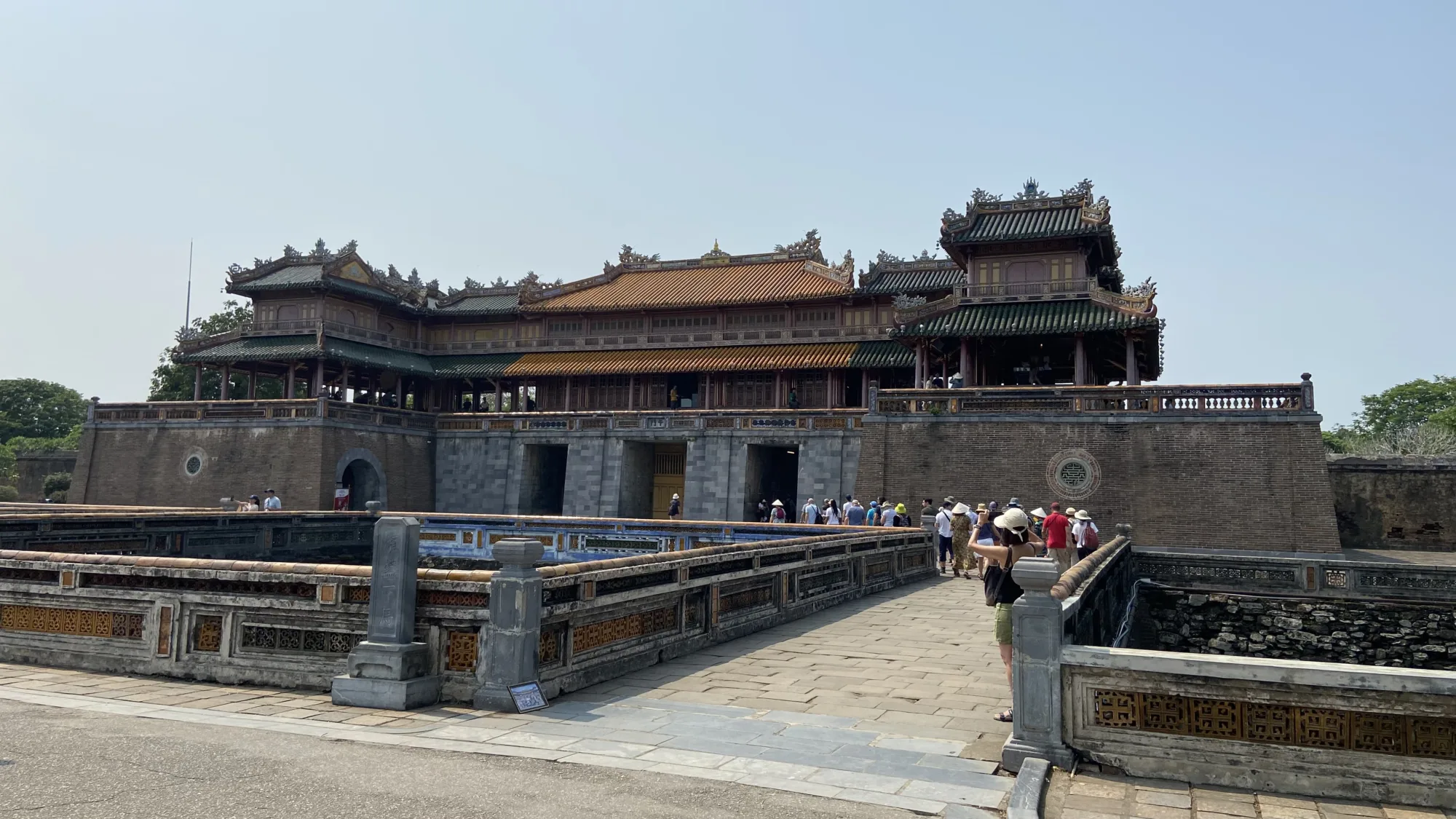The sun began its descent, casting golden hues over the ancient city of Hue. I found myself standing at the gates of history, ready to embark on a journey through time within the walls of Vietnam’s Imperial Citadel. This trip was different from my Hanoi and Ho Chi Minh City trips because it offered a travel back to the past.
Our group, with our knowledgeable guide, Hieu, leading the pack, set out to uncover the secrets and stories hidden within this UNESCO World Heritage Site.


The early beginnings of the Imperial Citadel
The Imperial Citadel of Hue, much akin to Beijing’s Forbidden City, stands as a testament to Vietnam’s rich cultural heritage and royal legacy. Emperor Gia Long built the citadel in the early 19th century. In fact, the Nguyen Dynasty used it as their political, cultural, and religious center for over a century.
Stepping through the towering gates, the moment immediately transported me back in time to an era of emperors, concubines, and courtly intrigue. It was reminiscent of the splendor of China’s imperial past.
Our first stop was the majestic Ngo Mon Gate, the principal entrance to the citadel. As we passed beneath its imposing arches, Hieu regaled us with tales of imperial ceremonies and grand processions that once graced these grounds. Beyond the gate, we entered the vast courtyard, surrounded by ornate pavilions and manicured gardens.



What to see inside the Imperial Citadel
As we wandered through the maze of halls and courtyards, we encountered the imposing Thai Hoa Palace, where emperors held court and received foreign dignitaries. Its intricate wooden carvings and gilded decorations spoke volumes of the opulence and grandeur of the Nguyen Dynasty.
Hieu explained the meanings behind the decorations and the photos on the walls of the hallway. We could admire the elaborate dragons symbolizing imperial power as well as the delicate lotus motifs representing purity and enlightenment.








A walk back in time
Nearby, the Hall of Mandarins stood as a silent witness to the political machinations that shaped the fate of the empire. Exhibits showcased the intricate bureaucracy of the Nguyen Dynasty, with displays of official robes, documents, and artifacts illustrating the roles and responsibilities of government officials.
As we explored further, Hieu pointed out the remnants of ancient palaces and temples, each bearing silent testimony to the tumultuous history of Vietnam. From the Forbidden Purple City, where only the emperor and his concubines were allowed to tread, to the serene gardens of the Nine Dynastic Urns, every corner of the citadel echoed with the whispers of bygone days.






More attractions for visitors
Visits to other attractions within the citadel, such as the Royal Gardens and the Royal Theatre, enriched our journey through Vietnam’s history. Traditional performances once entertained the imperial court in these cultural treasures, offering glimpses into the lavish lifestyle of the royal family and their enduring patronage of the arts.
Despite the sweltering heat of the afternoon sun, our group pressed on, eager to uncover every hidden corner of this historic treasure. Just when we thought we couldn’t endure the heat any longer, a soft drizzle began to fall, cooling our brows and refreshing our spirits. It was as if the heavens themselves had intervened to bless our journey through time.






Basic information about the Imperial Citadel
As we bid farewell to the Imperial Citadel, I couldn’t help but feel a sense of gratitude for the opportunity to experience firsthand the grandeur and majesty of Vietnam’s imperial past. The memories of our afternoon adventure would stay with me forever, a reminder of the enduring legacy of Hue’s Imperial City.
For travelers planning to visit the Imperial Citadel of Hue, I recommend that you arrive early to beat the crowds and the heat. The citadel is open daily from 8:00 AM to 5:30 PM, with an entrance fee of around 200,000 VND (approximately $8 USD). Guided tours, like the one led by Hieu, are available for those seeking a deeper understanding of the citadel’s history and significance. We availed this tour via Klook, which included other stops from Da Nang to Hue.





Inside the citadel, amenities such as rest areas, souvenir shops, and refreshment stalls are readily available to visitors, making it easy to spend an entire day exploring its wonders. Whether you’re a history buff, a culture enthusiast, or simply a curious traveler, the Imperial Citadel of Hue promises an unforgettable journey through the annals of Vietnam’s storied past.
